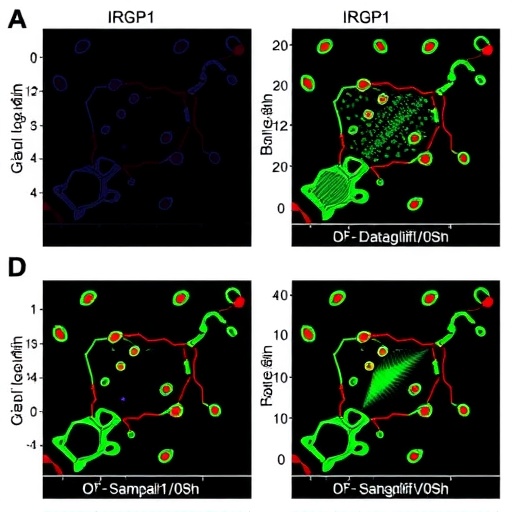In an innovative study, researchers conducted a groundbreaking investigation into the molecular mechanisms underlying meat quality in Qiandongnan Xiaoxiang chickens, revealing intriguing sex-dependent variations. This research integrates transcriptomic and metabolomic analyses to provide a comprehensive understanding of how sex influences meat quality attributes. The findings from this study not only shed light on biological processes but also have significant implications for the poultry industry.
The primary focus of the study was to explore the differing mechanisms by which male and female Qiandongnan Xiaoxiang chickens regulate meat quality. By combining transcriptome sequencing with metabolome assessments, the research team has established a nuanced understanding of this sex-based differential regulation. It is widely recognized that the quality of meat, encompassing traits such as tenderness, flavor, and juiciness, is a complex trait influenced by various genetic, environmental, and physiological factors.
In conducting this intricate research, the scientists collected samples from both male and female chickens, allowing them to analyze sex-specific differences in gene expression and metabolite composition. The transcriptomic analysis led to the identification of various genes that are differentially regulated based on sex. These genes are involved in critical biological pathways, including those governing muscle development, fat deposition, and metabolic functionality, all of which are essential for determining meat quality.
The metabolomic analysis complemented the transcriptomic findings by profiling a wide range of metabolites. This analysis revealed that male and female chickens not only differ in gene expression patterns but also exhibit distinctive metabolite profiles. Typically, metabolites such as amino acids, fatty acids, and organic acids play crucial roles in influencing sensory characteristics of meat. Understanding these differences is key to optimizing breeding strategies as well as improving overall meat quality.
One of the significant findings of the study was the role of sex-specific metabolites. For instance, certain amino acids that are more prevalent in male chickens contribute to the enhanced flavor profile of their meat. Conversely, female chickens showed a unique composition of fatty acids that impart different sensory attributes. This suggests that the sex of the poultry not only affects meat quality but also opens new avenues for targeted nutritional strategies to enhance these qualities.
The implications of this research extend beyond academic interest; they have practical relevance for poultry producers. With the knowledge gained from this study, breeding programs can be tailored to select for desirable traits in a sex-specific manner. By understanding which metabolites enhance meat quality in males versus females, poultry breeders can make informed decisions that ultimately lead to improved product offerings in the marketplace.
Moreover, the integration of multi-omics approaches, such as transcriptomics and metabolomics, exemplifies the power of modern scientific techniques in unraveling complex biological phenomena. This study stands as a benchmark for future research endeavors aiming to decode the genetic and molecular intricacies influencing meat quality across various livestock species.
In recent years, the poultry sector has faced increasing demands for high-quality meat in a competitive market. Consumer preferences are shifting towards not just the quantity, but also the quality and flavor of meat products. As a result, understanding the gene and metabolite interactions that influence these desirable qualities becomes even more essential to meet market expectations and enhance consumer satisfaction.
Further research is encouraged to delve deeper into the interactions between genetic and environmental factors that might influence these observed sex differences. Such an understanding will provide additional layers of information that can help optimize husbandry practices and nutritional management strategies in poultry farming.
Through this study and the innovative methods employed, the research team has paved the way for future explorations in the realm of livestock genomics. It also underscores the importance of applying high-throughput technologies to unravel the complexities of biological systems. The ongoing evolution of poultry genetics will no doubt benefit from insights such as those presented in this research.
As we move forward, it is crucial for the scientific community to continue fostering collaborations that span the fields of genomics, nutrition, and animal husbandry. This interdisciplinary approach can significantly advance our capabilities to produce healthier and more flavorful meat products that appeal to consumers globally.
In conclusion, the study conducted on Qiandongnan Xiaoxiang chickens provides essential insights into the biochemical and genetic underpinnings of meat quality, highlighting the fascinating and complex interplay between sex and meat characteristics. The findings call for a re-evaluation of breeding strategies and nutritional interventions that could revolutionize poultry production while meeting modern demands for quality meat.
This cutting-edge research undoubtedly sets a precedent for the future of poultry science, emphasizing the need to understand the intricate relationships between genes, metabolites, and the environment in the context of meat quality. By continuing to investigate these correlations, the agricultural sector can enhance production practices, leading to healthier, tastier, and more sustainable food sources for consumers around the world.
Subject of Research: The regulation of meat quality in Qiandongnan Xiaoxiang chickens based on sex differences.
Article Title: Integrating transcriptome and metabolome reveals sex-dependent meat quality regulation in Qiandongnan Xiaoxiang chickens.
Article References:
Hao, M., Xie, Y. & Li, C. Integrating transcriptome and metabolome reveals sex-dependent meat quality regulation in Qiandongnan Xiaoxiang chickens.
BMC Genomics (2025). https://doi.org/10.1186/s12864-025-12316-z
Image Credits: AI Generated
DOI:
Keywords: Transcriptomics, Metabolomics, Qiandongnan Xiaoxiang chickens, Meat Quality, Sex Differences
Tags: biological pathways in meat qualityfat deposition in chickensgene expression in chicken muscleinnovative poultry research methodsmale vs female chicken meat differencesmeat tenderness and flavor traitsmetabolomic assessment of chicken meatpoultry industry implicationsQiandongnan Xiaoxiang chickenssex-dependent meat qualitysex-specific metabolite compositiontranscriptomic analysis in poultry






